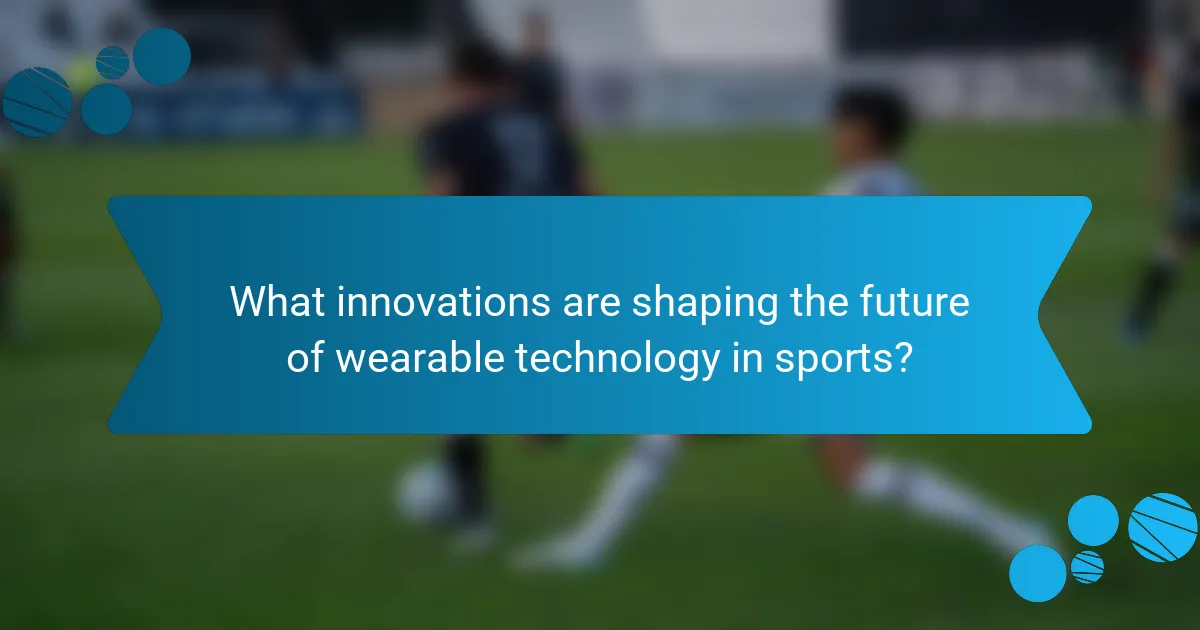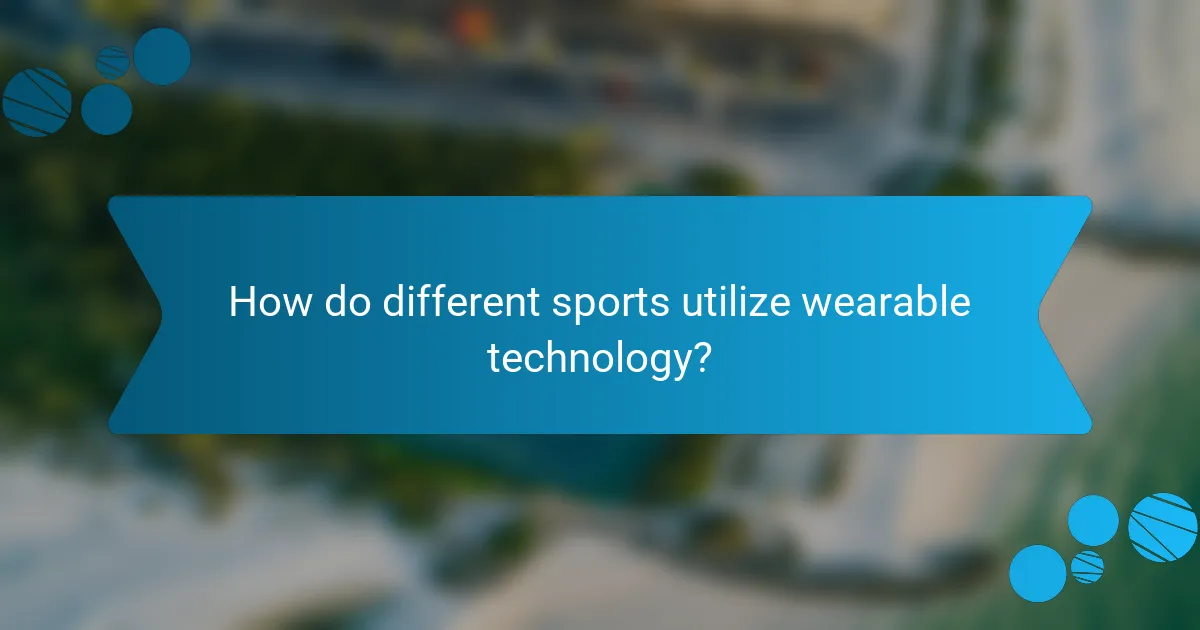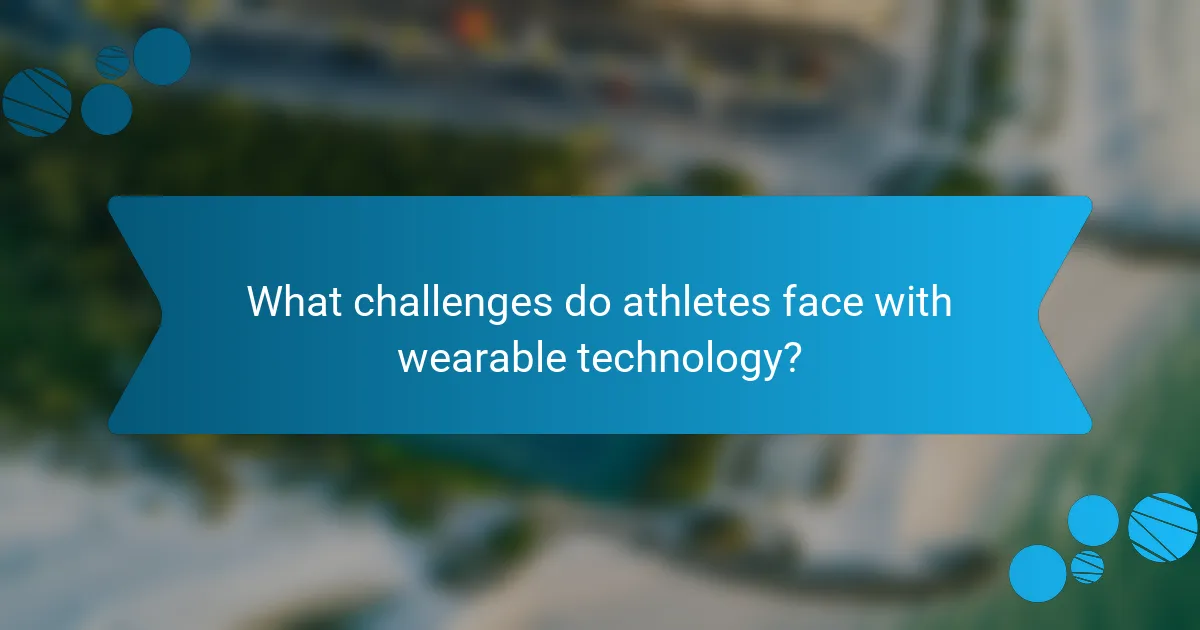Wearable technology significantly enhances sports performance by providing real-time data and improving training efficiency. This article explores the benefits of wearables, highlights innovations like smart fabrics and augmented reality, and discusses future trends in data analytics and sustainability. Additionally, it addresses the challenges athletes face, such as data accuracy and user comfort, while offering best practices for maximizing performance.

What are the key benefits of wearable technology in sports performance?
Wearable technology enhances sports performance by providing real-time data, improving training efficiency, and facilitating injury prevention. These devices track metrics such as heart rate, sleep quality, and movement patterns, enabling athletes to optimize their routines. As a result, athletes can make informed decisions, tailor their training, and enhance recovery. Innovations like smart fabrics and advanced sensors further drive the evolution of wearable technology, promising even greater insights into performance in the future.
How does real-time data enhance athletic training?
Real-time data significantly enhances athletic training by providing immediate feedback on performance metrics. Wearable technology, such as fitness trackers and smartwatches, monitors heart rate, speed, and endurance. This data allows athletes to adjust their training intensity and techniques on-the-fly. For example, a runner can modify their pace based on real-time heart rate data, optimizing performance and reducing injury risk. Moreover, data analytics can identify patterns in training, helping coaches tailor programs to individual athlete needs. The integration of real-time data into training regimens represents a unique attribute of modern sports performance enhancement.
Which health metrics can be monitored through wearables?
Wearable technology can monitor various health metrics, including heart rate, sleep patterns, activity levels, and blood oxygen saturation. These metrics help athletes optimize performance and track recovery. Advanced wearables may also measure stress levels and body temperature, providing a comprehensive view of an individual’s health.
Why do athletes prefer specific wearable brands?
Athletes prefer specific wearable brands due to reliability, accuracy, and brand reputation. These attributes enhance performance tracking and injury prevention. Brands like Garmin and Fitbit are favoured for their innovative features and user-friendly interfaces. Quality data and advanced analytics drive athletes to select trusted brands that meet their specific needs.

What innovations are shaping the future of wearable technology in sports?
Innovations in wearable technology are enhancing sports performance through advanced metrics and real-time data analysis. Key developments include smart fabrics that monitor biometrics, augmented reality glasses for immersive training, and AI-driven analytics for personalized coaching. These innovations improve athlete performance, injury prevention, and recovery tracking. Emerging trends focus on integrating wearables with IoT devices, enabling seamless data sharing and enhancing training efficiency.
How are AI and machine learning influencing performance analysis?
AI and machine learning significantly enhance performance analysis in sports by providing real-time data insights and predictive analytics. Wearable technology collects vast amounts of data, which AI algorithms analyze to identify performance patterns and optimize training regimens. Innovations like motion tracking and biometric monitoring lead to more personalized coaching strategies. Future trends indicate a growing integration of AI in injury prevention and recovery processes, ensuring athletes maintain peak performance levels.
What role does augmented reality play in training environments?
Augmented reality enhances training environments by providing immersive, interactive experiences. It allows athletes to visualize performance metrics and engage in real-time feedback. This technology improves skill acquisition and retention through simulated scenarios. For example, AR can project tactical plays onto the field, helping players understand strategies better. As a result, training becomes more efficient and effective, leading to improved sports performance outcomes.
Which new materials are being used for improved comfort and durability?
Innovative materials enhancing comfort and durability in wearable technology include breathable fabrics, moisture-wicking textiles, and lightweight composites. These advancements improve athlete performance by reducing friction and regulating temperature. Additionally, smart textiles integrate sensors for real-time data without compromising comfort.

How do different sports utilize wearable technology?
Different sports utilize wearable technology to enhance performance, monitor health, and prevent injuries. Athletes wear devices that track metrics like heart rate, distance, and speed. For example, football players use GPS trackers to analyze movement patterns, while runners rely on smartwatches to measure pace and endurance. Innovations include real-time data analytics, which provide instant feedback for training adjustments. The future of wearable technology in sports points toward more integrated health monitoring, offering insights into recovery and injury prevention.
What unique applications exist in team sports versus individual sports?
Wearable technology has unique applications in team sports compared to individual sports. In team sports, devices enhance communication and strategy through real-time data sharing. For instance, GPS trackers monitor player positions, enabling coaches to adjust tactics dynamically. In individual sports, wearables focus more on personal performance metrics, such as heart rate and endurance. This distinction highlights how team-oriented wearables foster collaboration, while individual devices emphasize self-improvement.
How are wearables adapting to extreme sports environments?
Wearable technology is increasingly adapting to extreme sports environments by enhancing durability, functionality, and real-time data tracking. These devices now feature robust materials that withstand harsh conditions, such as water resistance and shockproof designs. Innovations include advanced sensors that monitor vital signs and performance metrics specific to extreme activities, like altitude and temperature. Future trends suggest further integration of AI for personalized coaching and safety alerts, ensuring athletes can push their limits while minimizing risks.

What challenges do athletes face with wearable technology?
Athletes face several challenges with wearable technology, including data accuracy, battery life, and user comfort. Data accuracy can be affected by environmental factors, leading to unreliable performance metrics. Battery life often limits continuous monitoring during training sessions or competitions. User comfort is crucial, as bulky or poorly fitting devices can hinder movement and performance. Additionally, the integration of data into training programs can be complex, requiring athletes and coaches to interpret insights effectively.
How does data privacy affect athlete willingness to use wearables?
Data privacy significantly impacts athlete willingness to use wearables. Concerns about data security and unauthorized access can deter athletes from adopting these technologies. Many athletes prioritize personal data protection, fearing misuse or breaches. As a result, manufacturers must enhance security features to build trust and increase adoption rates.
What are the common technical issues reported by users?
Common technical issues reported by users of wearable technology in sports performance include connectivity problems, inaccurate data tracking, battery life concerns, software glitches, and discomfort during use. These issues can hinder the overall effectiveness of the devices.
Connectivity problems often arise when syncing devices with smartphones or other platforms, leading to data loss. Inaccurate data tracking can result from sensor malfunctions or improper fit, affecting performance analysis. Battery life concerns are prevalent, especially during extended usage. Software glitches may cause apps to crash or fail to update data correctly. Lastly, discomfort can deter athletes from wearing the technology consistently, impacting their training and performance.

What future trends can we expect in wearable technology for sports?
Wearable technology in sports is evolving rapidly, with trends focusing on enhanced data analytics, improved user experience, and integration with AI. These innovations aim to provide athletes with real-time insights into performance metrics, recovery times, and injury prevention strategies.
One significant trend is the development of advanced sensors that monitor biometrics, such as heart rate variability and oxygen saturation, allowing for personalized training regimens. Additionally, wearable devices are increasingly incorporating augmented reality features to enhance training and gameplay experiences.
Sustainability is becoming a priority, with manufacturers exploring eco-friendly materials and energy-efficient designs. As a result, athletes can expect more durable and environmentally conscious wearable technology options in the near future.
Lastly, the integration of wearable technology with smart clothing is on the rise, offering seamless data collection without compromising comfort. This trend signifies a move towards more discreet and user-friendly wearable solutions in sports performance.
How will advancements in battery life impact usage?
Advancements in battery life will significantly enhance wearable technology usage in sports performance. Longer battery life allows athletes to utilize devices throughout training and competitions without interruption. This leads to improved data collection, real-time feedback, and enhanced performance tracking. As battery technology evolves, wearables will integrate more features, such as advanced analytics and health monitoring, providing athletes with comprehensive insights. Consequently, athletes can rely on these devices for longer durations, fostering consistent performance enhancements and better decision-making during crucial moments.
Which emerging technologies could redefine sports performance tracking?
Wearable technology, including smart sensors and biometric devices, is set to redefine sports performance tracking. These innovations enhance data accuracy, providing real-time insights into athlete performance and health metrics.
Emerging technologies such as AI-driven analytics and advanced motion capture systems are revolutionizing how athletes train and compete. For example, machine learning algorithms can analyze vast datasets to identify performance patterns and suggest personalized training regimens.
The future trends in wearable technology include improved battery life and miniaturization, allowing for more seamless integration into athletes’ routines. Enhanced connectivity through 5G will enable instant data sharing, facilitating better coaching and strategy adjustments during competitions.
In summary, the intersection of wearable technology and sports performance tracking is rapidly evolving, promising significant advancements in athlete monitoring and training optimization.
What are the potential ethical implications of enhanced monitoring?
Enhanced monitoring in sports performance raises significant ethical implications. Privacy concerns emerge as athletes may feel surveilled, impacting their mental well-being. Data ownership issues arise, questioning who controls the collected information. Additionally, the potential for misuse of data, such as performance manipulation, poses risks. Transparency in data usage is essential to maintain trust between athletes and organizations. Finally, unequal access to wearable technology can create disparities in performance enhancement opportunities among athletes.

What best practices should athletes follow when using wearables?
Athletes should follow best practices for using wearables to maximize performance and ensure accurate data collection. First, calibrate devices according to manufacturer guidelines for precise measurements. Second, maintain consistent usage during training and competitions to track progress effectively. Third, regularly update software to benefit from the latest features and improvements. Fourth, analyze data comprehensively to identify patterns and areas for improvement. Lastly, ensure proper fit and comfort to prevent distractions or injuries during physical activity.
How can athletes effectively integrate wearables into their training routine?
Athletes can effectively integrate wearables into their training routine by setting clear goals, selecting appropriate devices, and analyzing data consistently. First, athletes should define specific performance objectives, such as improving endurance or tracking recovery. Next, they must choose wearables that align with these goals, considering features like heart rate monitoring or GPS tracking. Regularly reviewing and interpreting the data collected helps athletes make informed adjustments to their training plans. This approach enhances training effectiveness and promotes better performance outcomes.
What common mistakes should be avoided when interpreting data?
Common mistakes to avoid when interpreting data include overgeneralizing findings, neglecting context, and failing to account for biases. Misunderstanding correlation versus causation can lead to incorrect conclusions. Additionally, relying on outdated or incomplete data may skew results. It’s crucial to validate sources and ensure data relevance to enhance accuracy in analysis.
Which strategies optimize the benefits of wearable technology in sports?
Wearable technology in sports can be optimized through data integration, personalized training plans, and real-time feedback. These strategies enhance performance monitoring, injury prevention, and athlete engagement.
1. Data Integration: Combine data from various devices for comprehensive insights.
2. Personalized Training Plans: Tailor workouts based on individual metrics and goals.
3. Real-time Feedback: Provide immediate performance analysis to adjust techniques.
These strategies leverage the unique attributes of wearable technology, such as tracking heart rate variability and sleep patterns, to maximize benefits in sports performance.